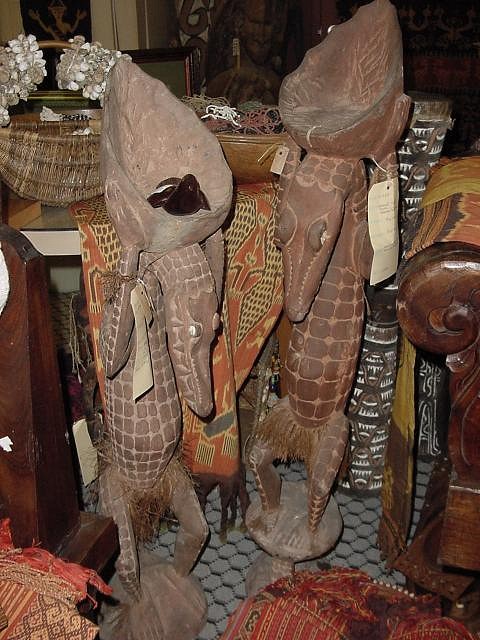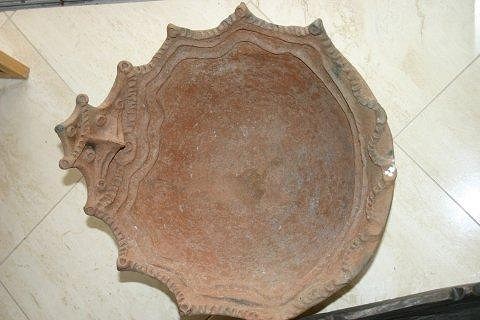Tiki Central / Collecting Tiki / Oceania, Etc: vendor of South Seas Art
Post #164720 by I dream of tiki on Thu, Jun 9, 2005 8:38 AM
|
IDOT

I dream of tiki
Posted
posted
on
Thu, Jun 9, 2005 8:38 AM
PNG Crocodile Statues "Chambri pottery is essential for food preparation and storage in the thatched stilt houses along the Sepik River. Although some cooking is done outside, each house has an area where clay is brought in to provide a stable, fire-proof base for a gugumbe or fire dish or fireplace which is about 2-5 ft. in diameter, above. Some Aibom clay Sago pots from the Murik Lake in East Sepik bear the sought after birds head as this one does (a spirit face designed to protect the contents of the pot). Only the Iatmul speaking village of Aibom has suitable clay to make this style of pottery achieved with the coil method. The village sits inland off the middle Sepik River in the Chambri Lakes. Women collect clay from pits at the foot of Aibom Mountain behind the village. In addition to fireplaces, Aibom women make sago storage jars and other smaller pieces. Most women make pots of all types during the wet season. If they marry outside the village they lose their access to the clay pits, but they can still make pots. A potter starts with a double thickness base and adds coils of rolled clay in sausage-shape pieces skillfully placed one above another to build up the form till a finished shape emerges. The coils are smoothed to complete the pot. The pots are dried to the leather-hard stage under the stilt houses, a slow process in the tropics. Although men are also shown making a pot for ritual purposes, making pots is predominantly women's work. The village relies on the trade from these clay pots for much of its subsistence and they are often found in different villages of the Sepik area. Some decorations are often added, sometimes with filets or with finely detailed clay slip designs using natural earth colors of red, black and white. If the women shape the pots, the men traditionally shape the faces and figures on the ridge tiles, sago and ceremonial pots. Men also do the painting. Firing is done before a big market day. The pots are set out in the sun to finish drying, then fired by heaping dried sago palm fronds over the mounded pottery. The firing takes from 30-60 minutes. The pots are properly fired when they turn orange. This produces a very low fire pottery. Chambri pottery is traditionally traded, along with dried fish from the Lakes, for Sepik River sago flour and betel nut, as well as April River grass skirts. The Maringei people, who live close to the small channel into the Lakes, are the middlemen. Traders from Tanbanum village who also trade other pots from other areas, take the pottery as far north as the April River and south to the Murik Lakes near where the Sepik empties out into the sea. Everyone needs a Chambri fireplace and sago storage jars in their house, so there is a ready market."
On the left, a very old and large gathering basket from central Kalimantan, Borneo: Great craftsmanship: The weaving is tight, controlled and consistent. Pattern is simple but decorative. The four upright corner supports are in perfect shape. It has a wonderful patina. Such pieces were used to collect harvest 's goods in the fields and carried on one's back." [ Edited by: I dream of tiki 2009-02-21 22:50 ] |




